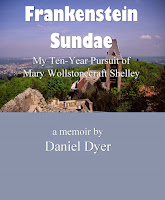While I was
chasing Mary Shelley all over the place, it was hard to keep myself from
getting overly interested in the other figures in her life. Some of them were most reluctant to let me move on. As is
evident in this memoir—a flooding pond that keeps spreading its waters all over
the farm (in serious need of a
dam!)—I have continually gone off in pursuit of some the other dominating (even
domineering) characters in her life, from her parents (Godwin and
Wollstonecraft), her husband (Bysshe Shelley), her acquaintances and friends
(Fanny Wright, Fanny Trollope), and those myriad other talents and personalities
whose lives were sometimes intersectant or asymptotic with her own—from
Coleridge to Keats, from Trelawny to Charles and Mary Lamb. And, of course, to
Byron, whose life was such a mixture of the feral and the intellectual that it’s
almost impossible to keep your eyes away from him.
I first found the
power of these distractions (but were
they?) while I was originally researching Mary’s life in the late 1990s and on
into the early 2000s; I have rediscovered them while I’ve been at work on this
endless memoir. As readers have seen in recent months, I have dived more thoroughly
into the lakes of the lives of Fanny Wright, in particular, and now I have need
for a flagellum with which to scourge myself when I begin thinking, Maybe I should write some more about Byron?
I mean, this guy, when he was a student at Cambridge, learning that it was
against the rules to keep a dog in his room, took a bear instead. No explicit
rule about that!
That’s right—a bear. On October 26, 1807, he wrote to friend
Elizabeth Bridget Pigot: I have got a new
friend, the finest in the world, a tame Bear, when I brought him here, they asked me what I meant to do with him,
and my reply was “he should sit for a
Fellowship.”[1]
A recent Byron
biographer, Benita Eisler, says that it’s likely the bear did not share his
tower room with him but probably was quartered
in the college stables.[2] And in a note to the Pigot
letter that tells about the bear, editor Leslie Marchand says that Byron later
sent the bear back to Newstead Abbey, where it joined Byron’s growing menagerie.[3]
Now … about that
menagerie …
You see what I mean? This can go on and on until my
fingers crack from abuse and my brain, overloaded, fizzles out in a spray of
sparks. And so, with a combination of reluctance and eagerness (like taking a
test I actually studied for), I’m going to return to Mary’s story next time—and
will try to stay focused.


No comments:
Post a Comment